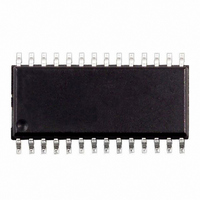ST72F260G1M6 STMicroelectronics, ST72F260G1M6 Datasheet - Page 168

ST72F260G1M6
Manufacturer Part Number
ST72F260G1M6
Description
MCU 8BIT 4K FLASH ICP 28SOIC
Manufacturer
STMicroelectronics
Series
ST7r
Datasheet
1.STEVAL-ISQ002V1.pdf
(172 pages)
Specifications of ST72F260G1M6
Core Processor
ST7
Core Size
8-Bit
Speed
16MHz
Connectivity
SPI
Peripherals
LVD, POR, PWM, WDT
Number Of I /o
22
Program Memory Size
4KB (4K x 8)
Program Memory Type
FLASH
Ram Size
256 x 8
Voltage - Supply (vcc/vdd)
2.7 V ~ 5.5 V
Oscillator Type
Internal
Operating Temperature
-40°C ~ 85°C
Package / Case
28-SOIC (7.5mm Width)
Data Converters
A/D 6x10b
Processor Series
ST72F2x
Core
ST7
Data Bus Width
8 bit
Data Ram Size
256 B
Interface Type
I2C/SCI/SPI
Maximum Clock Frequency
8 MHz
Number Of Programmable I/os
22
Number Of Timers
3
Operating Supply Voltage
2.7 V to 5.5 V
Maximum Operating Temperature
+ 85 C
Mounting Style
SMD/SMT
Development Tools By Supplier
ST7F264-IND/USB, ST72F34X-SK/RAIS, ST7MDT10-DVP3, ST7MDT10-EMU3, STX-RLINK
Minimum Operating Temperature
- 40 C
On-chip Adc
6-ch x 10-bit
Controller Family/series
ST7
No. Of I/o's
22
Ram Memory Size
256Byte
Cpu Speed
8MHz
No. Of Timers
2
Embedded Interface Type
I2C, SCI, SPI
Rohs Compliant
Yes
For Use With
497-5046 - KIT TOOL FOR ST7/UPSD/STR7 MCU
Lead Free Status / RoHS Status
Lead free / RoHS Compliant
Eeprom Size
-
Lead Free Status / Rohs Status
Lead free / RoHS Compliant
Other names
497-4840
Available stocks
Company
Part Number
Manufacturer
Quantity
Price
ST72260Gx, ST72262Gx, ST72264Gx
16 KNOWN LIMITATIONS
16.1 ALL FLASH AND ROM DEVICES
16.1.1 16-bit timer PWM Mode
In PWM mode, the first PWM pulse is missed after
writing the value FFFCh in the OC12R register.In
PWM mode, the first PWM pulse is missed after
writing the value FFFCh in the OC1R register
(OC1HR, OC1LR). It leads to either full or no PWM
during a period, depending on the OLVL1 and
OLVL2 settings.
16.1.2
interrupt routine
When an active interrupt request occurs at the
same time as the related flag or interrupt mask is
being cleared, the CC register may be corrupted.
Concurrent interrupt context
The symptom does not occur when the interrupts
are handled normally, i.e. when:
– The interrupt request is cleared (flag reset or in-
– The interrupt request is cleared (flag reset or in-
– The interrupt request is cleared (flag reset or in-
If these conditions are not met, the symptom can
be avoided by implementing the following se-
quence:
Perform SIM and RIM operation before and after
resetting an active interrupt request
Nested interrupt context
The symptom does not occur when the interrupts
are handled normally, i.e. when:
– The interrupt request is cleared (flag reset or in-
– The interrupt request is cleared (flag reset or in-
168/172
Ex:
terrupt mask) within its own interrupt routine
terrupt mask) within any interrupt routine
terrupt mask) in any part of the code while this in-
terrupt is disabled
terrupt mask) within its own interrupt routine
terrupt mask) within any interrupt routine with
higher or identical priority level
SIM
reset flag or interrupt mask
RIM
Clearing
active
interrupts
outside
– The interrupt request is cleared (flag reset or in-
If these conditions are not met, the symptom can
be avoided by implementing the following se-
quence:
16.1.3 I2C Multimaster
In multimaster configurations, if the ST7 I2C re-
ceives a START condition from another I2C mas-
ter after the START bit is set in the I2CCR register
and before the START condition is generated by
the ST7 I2C, it may ignore the START condition
from the other I2C master. In this case, the ST7
master will receive a NACK from the other device.
On reception of the NACK, ST7 can send a re-start
and Slave address to re-initiate communication
16.1.4 Functional EMS
The functional EMS (Electro Magnetic Susceptibil-
ity) severity level/behaviour class is 2B as defined
in application note AN1709.
Special care should be taken when designing the
PCB layout and firmware (refer to application
notes AN898, AN901 and AN1015) in sensitive
applications (that use switches for instance). For
more information refer to application note AN1637.
16.2 FLASH DEVICES ONLY
16.2.1 Execution of BTJX instruction
When testing the address $FF with the "BTJT" or
"BTJF" instructions, the CPU may perform an in-
correct operation when the relative jump is nega-
tive and performs an address page change.
To avoid this issue, including when using a C com-
piler, it is recommended to never use address
$00FF as a variable (using the linker parameter for
example).
terrupt mask) in any part of the code while this in-
terrupt is disabled
PUSH CC
SIM
reset flag or interrupt mask
POP CC
1













